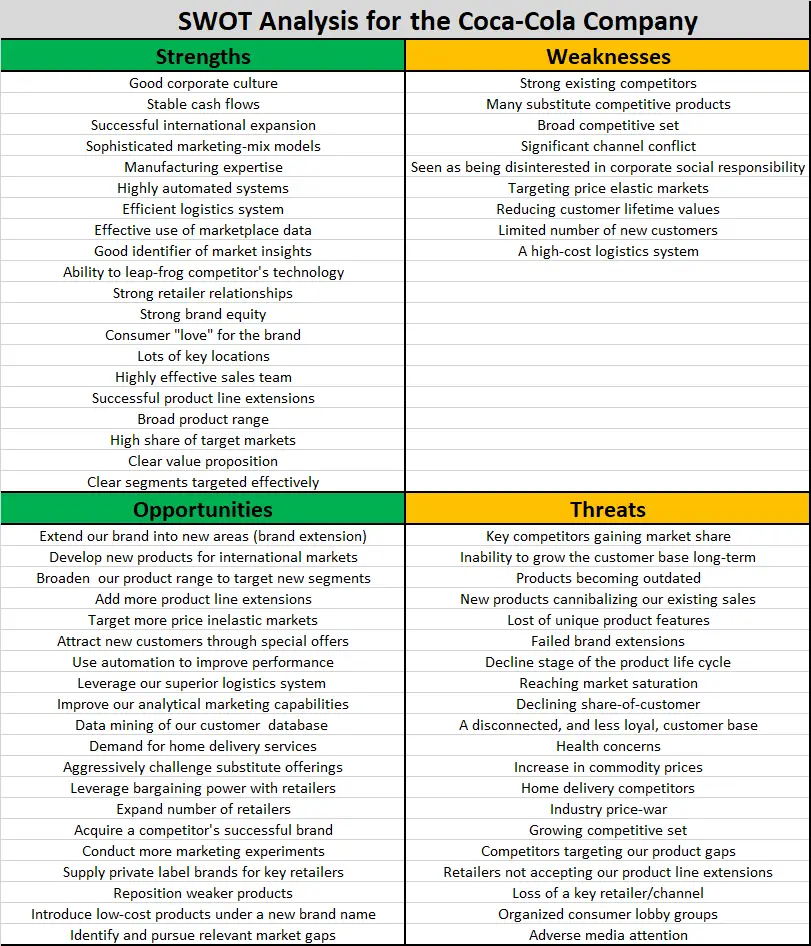In this example SWOT for Coca-Cola you will find 50+ ideas to help get you started.
And while you’re here – also check out the Free SWOT Maker (Using Excel)
Coca-Cola is one of the strongest fast moving consumer goods (FMCG’s) brands in the world. Its flagship product was launched in the 1800s and the company has expanded successfully internationally and has developed a very broad range of beverage products.
Possible SWOT Analysis Ideas for the Coca-Cola Company
Here are some possible ideas to feed into a SWOT analysis for Coca-Cola – as you can see, being such a strong established brand, they probably have less weaknesses than other firms.
Below is an example SWOT output from the Free SWOT Maker (Using Excel)
Summary SWOT Analysis for Coca-Cola
Helpful further information for a SWOT Analysis for Coca-Cola
Repositioning Coca-Cola and Pepsi in the Cola Wars era
A Little Bit About Coca-Cola
Coca-Cola history began in 1886 when the curiosity of an Atlanta pharmacist, Dr. John S. Pemberton, led him to create a distinctive tasting soft drink that could be sold at soda fountains.
He created a flavored syrup, took it to his neighborhood pharmacy, where it was mixed with carbonated water and deemed “excellent” by those who sampled it.
Dr. Pemberton’s partner and bookkeeper, Frank M. Robinson, is credited with naming the beverage “Coca‑Cola” as well as designing the trademarked, distinct script, still used today.
Source: Coca-Cola History
What are FMCG’s?
Fast-moving consumer goods (FMCG), also called consumer packaged goods (CPG), refer to products that are highly in-demand, sold quickly, and affordable. Such items are considered “fast-moving” as they are quick to leave the shelves of a store or supermarket because consumers use them on a regular basis.
Source: Corporate Finance Institute
Why You Should Use a SWOT
A business should use a SWOT analysis for several key reasons:
Strategic Planning: SWOT analysis helps in identifying the strengths, weaknesses, opportunities, and threats related to business competition or project planning. This understanding is crucial for any strategic planning initiative.
Informed Decision-Making: It enables businesses to make informed decisions by considering both internal and external factors. Understanding internal strengths and weaknesses alongside external opportunities and threats allows for a more comprehensive decision-making process.
Identifying Opportunities: By analyzing external opportunities, a business can capitalize on them effectively. This can involve exploring new markets, adapting to changes in consumer preferences, or leveraging emerging technologies.
Risk Management: Identifying potential threats allows businesses to develop strategies to mitigate risks. Being aware of external threats such as market competition, regulatory changes, or shifts in consumer behavior can help in proactive planning.
Resource Allocation: Understanding the company’s strengths and weaknesses helps in the efficient allocation of resources. Resources can be strategically directed towards areas where the company has a competitive advantage or needs improvement.
Competitive Advantage: SWOT analysis can reveal a company’s unique selling proposition and what differentiates it from its competitors. This insight is valuable for carving out a competitive advantage in the market.
Goal Alignment: It assists in aligning business goals with current market trends and internal capabilities, ensuring that the organization’s efforts are focused and effective.
Fostering Innovation: By constantly evaluating strengths, weaknesses, opportunities, and threats, organizations can foster a culture of continuous improvement and innovation.

